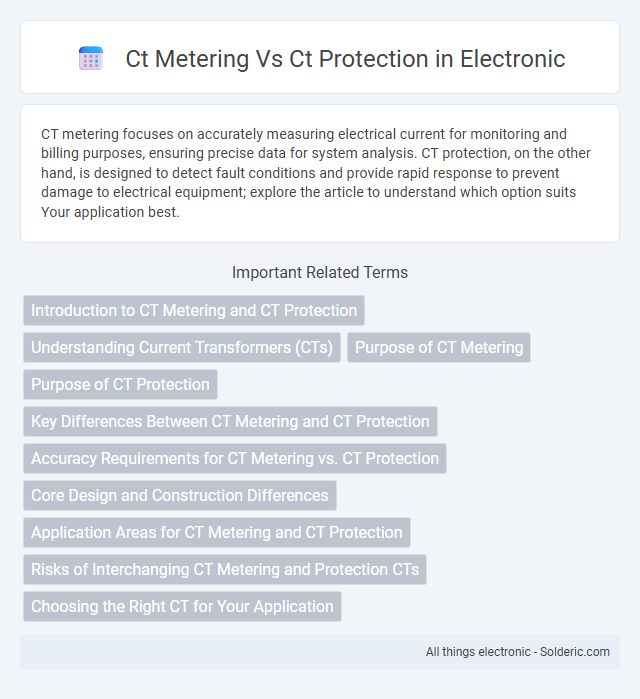CT metering focuses on accurately measuring electrical current for monitoring and billing purposes, ensuring precise data for system analysis. CT protection, on the other hand, is designed to detect fault conditions and provide rapid response to prevent damage to electrical equipment; explore the article to understand which option suits Your application best.
Comparison Table
| Feature | CT Metering | CT Protection |
|---|---|---|
| Purpose | Accurate measurement of current for billing and monitoring | Detect faults and abnormal conditions to trigger protective devices |
| Accuracy Class | Typically Class 0.1, 0.2, or 0.5 for precision | Usually Class 5P or 10P for reliable fault detection |
| Burden | Low burden to ensure minimal signal loss | Higher burden to handle relay and breaker inputs |
| Secondary Current | Standard 5A or 1A output for metering devices | Standard 5A or 1A output for protection relays |
| Core Type | Aluminum or silicon steel cores for accuracy | Silicon steel cores optimized for fast response |
| Thermal Rating | Designed for steady state continuous current | Designed to withstand short circuit currents briefly |
| Output Waveform | High fidelity waveform for accurate measurement | May slightly distort waveform but remains reliable for detection |
| Application | Energy meters, SCADA systems, and load monitoring | Overcurrent relays, differential protection, and circuit breakers |
Introduction to CT Metering and CT Protection
CT Metering involves the use of current transformers designed for accurate measurement of electrical current, ensuring precise data for billing and monitoring purposes. CT Protection utilizes current transformers specifically engineered to detect fault conditions and enable protective relays to isolate electrical faults, thereby safeguarding equipment and maintaining system stability. The distinction between CT Metering and CT Protection lies in their accuracy requirements and application focus, with metering CTs prioritizing measurement precision and protection CTs emphasizing durability and fault detection capabilities.
Understanding Current Transformers (CTs)
Current Transformers (CTs) serve distinct roles in electrical systems, with CT metering designed for precise measurement of electrical current, ensuring accurate billing and system monitoring. CT protection focuses on safeguarding equipment by detecting fault currents and triggering protective devices to prevent damage. Understanding the differences in construction, accuracy class, and application of CT metering versus CT protection helps optimize your electrical system's performance and safety.
Purpose of CT Metering
CT metering is designed to provide precise electrical measurements for billing and energy management by accurately scaling high current values to measurable levels. This ensures reliable data collection for power consumption analysis and load monitoring across electrical systems. Unlike CT protection, which focuses on fault detection and system safety, CT metering emphasizes accuracy and stability in continuous current measurement.
Purpose of CT Protection
CT protection is designed to safeguard current transformers from damage caused by overcurrent, short circuits, or insulation failures during electrical faults. It ensures accurate measurement by preventing saturation and overheating, which can lead to incorrect readings or equipment failure. Your electrical system's reliability depends on effective CT protection to maintain safety and operational integrity.
Key Differences Between CT Metering and CT Protection
CT metering focuses on precise measurement of electrical parameters such as current and power for billing and monitoring, while CT protection is designed to detect faults and abnormal conditions to trigger protective devices. Metering CTs prioritize accuracy and linearity within specified ranges, whereas protection CTs prioritize saturation resistance and rapid response to high fault currents. Your electrical system relies on accurate metering for operational efficiency and robust protection for system safety and reliability.
Accuracy Requirements for CT Metering vs. CT Protection
CT metering demands high accuracy with precise ratio and phase angle to ensure exact measurement of electrical parameters for billing and energy management. CT protection prioritizes rapid response and durability, allowing for slight accuracy trade-offs to quickly detect faults and safeguard equipment. Your choice depends on balancing the critical need for precision in metering against the need for speed and reliability in protective applications.
Core Design and Construction Differences
CT metering devices feature precision-engineered cores with uniform, low-loss materials to ensure accurate current measurement and minimal distortion. In contrast, CT protection devices utilize robust cores designed to handle high fault currents without saturation, prioritizing reliability and rapid response under extreme conditions. Your selection hinges on the application's need for accuracy versus durability, reflecting fundamental differences in core design and construction.
Application Areas for CT Metering and CT Protection
CT metering is primarily used in energy measurement and billing applications, ensuring accurate monitoring of electrical consumption in residential, commercial, and industrial settings. CT protection is designed to safeguard electrical systems by detecting faults and abnormal currents, commonly applied in power transformers, circuit breakers, and relay protection schemes. Understanding your specific application area helps determine whether CT metering or CT protection is essential for system reliability and efficiency.
Risks of Interchanging CT Metering and Protection CTs
Interchanging CT metering and protection CTs poses significant risks including inaccurate measurement data, which can compromise system monitoring and billing accuracy. Protection CTs typically have lower accuracy classes and higher saturation levels, potentially leading to malfunction or failure of protective relays during fault conditions. Using metering CTs for protection can result in delayed fault detection and increased equipment damage, jeopardizing overall electrical system safety and reliability.
Choosing the Right CT for Your Application
Selecting the right Current Transformer (CT) depends on whether your application requires metering or protection, as metering CTs prioritize accuracy for precise measurements, while protection CTs emphasize high accuracy during fault conditions. Your choice should consider factors such as burden, accuracy class, and primary rating to ensure optimal performance and safety. Properly matching the CT type to your system enhances reliability and safeguards equipment against overloads or faults.
ct metering vs ct protection Infographic

 solderic.com
solderic.com